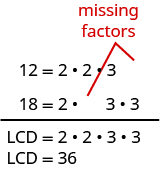Adding and Subtracting Fractions With Different Denominators
Learning Outcomes
- Add or subtract fractions with different denominators
- Identify and use fraction operations
Least Common Denominator
The least common denominator (LCD) of two fractions is the least common multiple (LCM) of their denominators.Equivalent Fractions Property
If [latex]a,b,c[/latex] are whole numbers where [latex]b\ne 0,c\ne 0,\text{then}[/latex][latex]\Large\frac{a}{b}=\Large\frac{a\cdot c}{b\cdot c}\normalsize\text{ and }\Large\frac{a\cdot c}{b\cdot c}=\Large\frac{a}{b}[/latex]
Add or subtract fractions with different denominators
- Find the LCD.
- Convert each fraction to an equivalent form with the LCD as the denominator.
- Add or subtract the fractions.
- Write the result in simplified form.
Example
Add: [latex]\Large\frac{1}{2}+\Large\frac{1}{3}[/latex] Solution:| [latex]\Large\frac{1}{2}+\Large\frac{1}{3}[/latex] | |
| Find the LCD of [latex]2[/latex], [latex]3[/latex]. |  |
| Change into equivalent fractions with the LCD [latex]6[/latex]. | [latex]\Large\frac{1\cdot\color{red}{3}}{2\cdot\color{red}{3}} +\Large\frac{1\cdot\color{red}{2}}{3\cdot\color{red}{2}}[/latex] |
| Simplify the numerators and denominators. | [latex]\Large\frac{3}{6}+\Large\frac{2}{6}[/latex] |
| Add. | [latex]\Large\frac{5}{6}[/latex] |
Try It
[ohm_question height="230"]146262[/ohm_question]Example
Subtract: [latex]\Large\frac{1}{2}-\left(-\Large\frac{1}{4}\right)[/latex]Answer: Solution:
| [latex]\Large\frac{1}{2}-\left(-\Large\frac{1}{4}\right)[/latex] | |
| Find the LCD of [latex]2[/latex] and [latex]4[/latex]. |  |
| Rewrite as equivalent fractions using the LCD [latex]4[/latex]. | [latex]\Large\frac{1\cdot\color{red}{2}}{2\cdot\color{red}{2}} - (--\Large\frac{1}{4})[/latex] |
| Simplify the first fraction. | [latex]\Large\frac{2}{4}-\left(-\Large\frac{1}{4}\right)[/latex] |
| Subtract. | [latex]\Large\frac{2-\left(-1\right)}{4}[/latex] |
| Simplify. | [latex]\Large\frac{3}{4}[/latex] |
Try It
[ohm_question height="230"]146264[/ohm_question]Example
Add: [latex]\Large\frac{7}{12}+\Large\frac{5}{18}[/latex]Answer: Solution:
| [latex]\Large\frac{7}{12}+\Large\frac{5}{18}[/latex] | |
| Find the LCD of [latex]12[/latex] and [latex]18[/latex]. |  |
| Rewrite as equivalent fractions with the LCD. | [latex]\Large\frac{7\cdot\color{red}{3}}{12\cdot\color{red}{3}} +\Large\frac{5\cdot\color{red}{2}}{18\cdot\color{red}{2}}[/latex] |
| Simplify the numerators and denominators. | [latex]\Large\frac{21}{36}+\Large\frac{10}{36}[/latex] |
| Add. | [latex]\Large\frac{31}{36}[/latex] |
Try It
[ohm_question height="230"]146265[/ohm_question] The LCD, [latex]36[/latex], has [latex]2[/latex] factors of [latex]2[/latex] and [latex]2[/latex] factors of [latex]3[/latex].
Twelve has two factors of [latex]2[/latex], but only one of [latex]3[/latex] —so it is ‘missing‘ one [latex]3[/latex]. We multiplied the numerator and denominator of [latex]\Large\frac{7}{12}[/latex] by [latex]3[/latex] to get an equivalent fraction with denominator [latex]36[/latex].
Eighteen is missing one factor of [latex]2[/latex] —so you multiply the numerator and denominator [latex]\Large\frac{5}{18}[/latex] by [latex]2[/latex] to get an equivalent fraction with denominator [latex]36[/latex]. We will apply this method as we subtract the fractions in the next example.
The LCD, [latex]36[/latex], has [latex]2[/latex] factors of [latex]2[/latex] and [latex]2[/latex] factors of [latex]3[/latex].
Twelve has two factors of [latex]2[/latex], but only one of [latex]3[/latex] —so it is ‘missing‘ one [latex]3[/latex]. We multiplied the numerator and denominator of [latex]\Large\frac{7}{12}[/latex] by [latex]3[/latex] to get an equivalent fraction with denominator [latex]36[/latex].
Eighteen is missing one factor of [latex]2[/latex] —so you multiply the numerator and denominator [latex]\Large\frac{5}{18}[/latex] by [latex]2[/latex] to get an equivalent fraction with denominator [latex]36[/latex]. We will apply this method as we subtract the fractions in the next example.
Example
Subtract: [latex]\Large\frac{7}{15}-\Large\frac{19}{24}[/latex]Answer: Solution:
| [latex]\Large\frac{7}{15}-\Large\frac{19}{24}[/latex] | |
| Find the LCD. |  [latex-display]15[/latex] is 'missing' three factors of [latex]2[/latex-display]
[latex]24[/latex] is 'missing' a factor of [latex]5[/latex]
[latex-display]15[/latex] is 'missing' three factors of [latex]2[/latex-display]
[latex]24[/latex] is 'missing' a factor of [latex]5[/latex] |
| Rewrite as equivalent fractions with the LCD. | [latex]\Large\frac{7\cdot\color{red}{8}}{15\cdot\color{red}{8}} -\Large\frac{19\cdot\color{red}{5}}{24\cdot\color{red}{5}}[/latex] |
| Simplify each numerator and denominator. | [latex]\Large\frac{56}{120}-\Large\frac{95}{120}[/latex] |
| Subtract. | [latex]-\Large\frac{39}{120}[/latex] |
| Rewrite showing the common factor of [latex]3[/latex]. | [latex]-\Large\frac{13\cdot 3}{40\cdot 3}[/latex] |
| Remove the common factor to simplify. | [latex]-\Large\frac{13}{40}[/latex] |
Try It
[ohm_question height="230"]146266[/ohm_question]Example
Add: [latex]-\Large\frac{11}{30}+\Large\frac{23}{42}[/latex]Answer: Solution:
| [latex]-\Large\frac{11}{30}+\Large\frac{23}{42}[/latex] | |
Find the LCD.
 |
|
| Rewrite as equivalent fractions with the LCD. | [latex]-\Large\frac{11\cdot\color{red}{7}}{30\cdot\color{red}{7}} +\Large\frac{23\cdot\color{red}{5}}{42\cdot\color{red}{5}}[/latex] |
| Simplify each numerator and denominator. | [latex]-\Large\frac{77}{210}+\Large\frac{115}{210}[/latex] |
| Add. | [latex]\Large\frac{38}{210}[/latex] |
| Rewrite showing the common factor of [latex]2[/latex]. | [latex]\Large\frac{19\cdot 2}{105\cdot 2}[/latex] |
| Remove the common factor to simplify. | [latex]\Large\frac{19}{105}[/latex] |
Try It
[ohm_question height="230"]146267[/ohm_question]Licenses & Attributions
CC licensed content, Original
- Question ID: 146262, 146264, 146265, 146266, 146267, 146268. Authored by: Alyson Day. License: CC BY: Attribution. License terms: IMathAS Community License CC-BY + GPL.
- Revision and Adaptation. Provided by: Lumen Learning License: CC BY: Attribution.
CC licensed content, Shared previously
- Ex: Add Fractions with Unlike Denominators (Basic with Model). Authored by: James Sousa (mathispower4u.com). License: CC BY: Attribution.
- Example: Subtract Fractions with Unlike Denominators. Authored by: James Sousa (mathispower4u.com). License: CC BY: Attribution.
CC licensed content, Specific attribution
- Prealgebra. Provided by: OpenStax License: CC BY: Attribution. License terms: Download for free at http://cnx.org/contents/[email protected].

